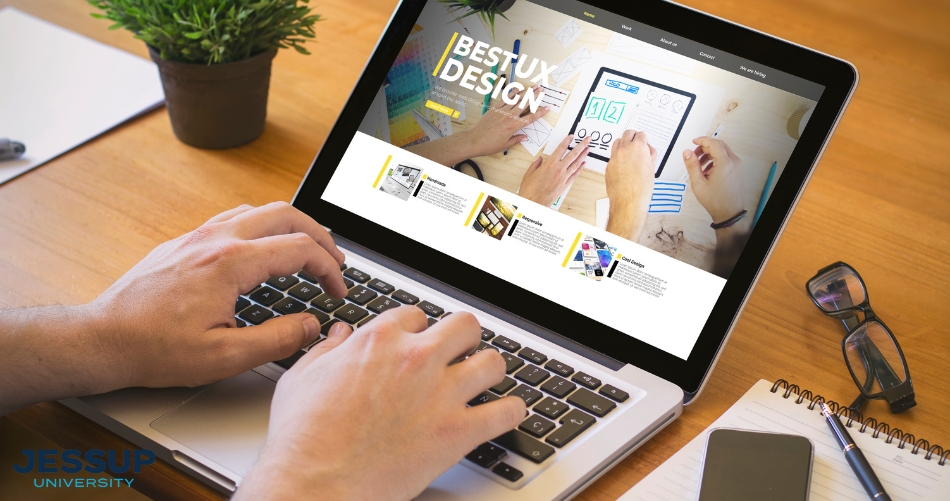Checking Out Creative Fads in Web Design for Modern Services
The landscape of web design is continuously progressing, showing the vibrant needs of modern-day businesses. Current fads highlight a preference for minimalism, bold typography, and engaging interactivity. Business increasingly focus on user experience through mobile-first principles and personalized web content. Additionally, an emphasis on sustainability is gaining grip. Recognizing these fads is important for companies intending to stick out in a congested marketplace. What implications do these changes hold for the future of digital interaction?
Accepting Vibrant Typography
Strong typography has become a defining element in contemporary web design, catching focus and sharing messages with striking quality. This fad focuses on visually impactful text that boosts user involvement and brand identification. Developers often use oversized typefaces and one-of-a-kind fonts to develop a pecking order, leading audiences through web content flawlessly.
The tactical use of bold typography permits for efficient narration, enabling brands to connect their values succinctly. It serves not just aesthetic functions however likewise practical ones, as it improves readability across gadgets and screen sizes.
As sites complete for user attention, strong typography attracts attention in a saturated digital landscape. Its convenience makes it possible for designers to try out contrasting shades and formats, further intensifying its efficiency. Inevitably, embracing vibrant typography represents a change in the direction of even more communicative and meaningful web design, cultivating a much deeper connection in between brand names and their audiences.
The Rise of Minimalist Design
As digital atmospheres become significantly cluttered, the rise of minimalist design offers an invigorating alternative that prioritizes simpleness and functionality. This layout approach remove unneeded components, permitting content to take center stage. By concentrating on clean lines, adequate white room, and a limited color combination, minimal style improves user experience and enhances navigating.
Companies embracing this fad aim to communicate their brand name message clearly and effectively, promoting a sense of tranquility and quality. The lack of disturbances assists users concentrate on crucial information, causing boosted interaction and conversion rates. In addition, minimalist style lines up well with mobile-first strategies, making sure that sites stay straightforward and accessible across various devices.
Ultimately, the rise of minimalist style mirrors a wider change towards prioritizing user requirements and choices, making it an effective tool for modern-day companies wanting to make a lasting effect in the digital landscape.
Immersive Animations and Interactivity
While numerous web designers welcome minimal aesthetics, another engaging pattern obtaining grip is making use of immersive computer animations and interactivity. This technique boosts user involvement by developing fascinating experiences that draw site visitors into the material. Developers employ vibrant components such as animated histories, scrolling impacts, and interactive infographics to communicate complicated concepts in an easily accessible fashion.
These animations not just provide visual interest yet also guide customers via the navigating procedure, making communications a lot more instinctive. As an example, float results and computer animated changes can urge users to check out further, causing enhanced time spent on the website.
Additionally, this fad aligns with the more comprehensive movement towards narration in web design, where computer animations act as narrative tools that convey brand messages properly. By integrating immersive animations and interactivity, companies can differentiate themselves in a congested online landscape, eventually enhancing user satisfaction and brand name commitment.
Mobile-First Design Concepts
Mobile-first design principles emphasize focusing on user experience by making certain web sites function perfectly on smaller screens. This strategy incorporates receptive format methods that adjust to numerous gadget dimensions while maintaining visual stability. Furthermore, it focuses on touchscreen navigating design, improving use for mobile customers.
Prioritizing User Experience
How can developers properly focus on user experience in an increasingly mobile-centric globe? Stressing mobile-first style concepts is important, as users mostly involve with web sites via mobile gadgets. This method urges developers to improve content, ensuring it is easily accessible and navigable on smaller screens. Secret practices consist of streamlining navigating, lessening tons times, and using touch-friendly aspects that improve interactivity. In addition, focusing on clear typography and intuitive layouts can substantially boost user contentment. Developers must continuously collect user feedback to fine-tune their approaches, adapting to advancing user requirements and choices. By concentrating on these aspects, services can develop an appealing electronic experience that fosters loyalty and drives conversions, eventually straightening with the assumptions these days's mobile customers.
Receptive Layout Strategies
Developers welcome receptive design strategies to develop versatile and flexible web experiences that deal with various screen dimensions. This method focuses on mobile-first layout principles, making sure peak functionality on smaller devices before scaling up for bigger displays. By making use of fluid grids, adaptable photos, and media inquiries, designers can keep a natural aesthetic identity across all systems. This method not only enhances user engagement yet also boosts online search engine positions, as mobile-friendly sites are preferred by search formulas. Furthermore, receptive designs allow companies to get to a wider audience, fitting individuals on smart devices, desktops, and tablet computers alike. Generally, carrying out these methods is crucial for modern-day web design, making certain that businesses remain affordable in an ever-evolving electronic landscape.
Touchscreen Navigation Style
With the surge of mobile phones, touchscreen navigating has come to be a fundamental element of web design. Developers are increasingly embracing mobile-first concepts to enhance user experience and interaction. Website Design Agency. Effective touchscreen navigation focuses on larger switches and intuitive motions, allowing individuals to connect quickly with material. This technique minimizes stress and encourages exploration, as users can navigate seamlessly with their fingers. Additionally, including swipe motions and tap performance provides to the all-natural behaviors of mobile individuals. Comments systems, such as visual cues and animations, enhance usability further by confirming actions. As touchscreens control user interactions, utilizing these style elements not only aligns with modern assumptions yet additionally cultivates an extra pleasurable and easily accessible browsing experience for all individuals
Customized User Experiences
What makes a user really feel absolutely involved on a site? The solution commonly hinges on customized user experiences. By customizing content and navigating to private choices, organizations can create a significant link with their target market. This personalization can be attained with different methods, such as analyzing user habits, making use of cookies, and using customized recommendations based upon previous interactions.
For example, e-commerce platforms that recommend products based on searching background not just boost user experience however likewise raise conversion rates. Additionally, integrating dynamic web content that adapts to the user's area or time of day can even more enhance involvement.
Furthermore, customized introductions or messages can make individuals really feel valued and understood. As i was reading this modern-day businesses seek to stick out in a competitive electronic landscape, embracing individualized user experiences comes to be necessary, fostering commitment and motivating repeat check outs. Inevitably, this strategy transforms a common internet site into an interactive system that reverberates with its audience.
Sustainability in Web Design
As the digital landscape continues to evolve, the importance of sustainability in web design has actually acquired considerable interest. Designers are significantly mindful of the environmental effect their developments can have, motivating a change in the direction of environment-friendly techniques (Website Design Agency). Sustainable web design focuses on enhancing internet sites to reduce energy consumption and carbon impacts. Techniques consist of utilizing minimalistic design principles, optimizing photos, and using reliable coding practices to enhance loading speeds
Additionally, the choice of organizing providers plays a necessary function; many developers are now choosing eco-friendly holding services powered by renewable resource. By focusing on access and easy go to these guys to use navigation, sustainable designs additionally satisfy a broader target market, enhancing usability. This conscious approach not just attract environmentally-minded consumers however also adds to the general longevity and performance of web sites. Ultimately, sustainability in web design shows a growing fad towards responsible digital practices that line up with contemporary service values.

Frequently Asked Concerns
Just How Can I Select the Right Color Design for My Site?
To select the appropriate color design for a web site, one need to consider the brand's identification, target market, and emotional influence. Using color theory and screening combinations can improve user experience and aesthetic appeal significantly.
What Are the Best Tools for Prototyping Website Design?
The very best devices for prototyping internet designs include Figma, Sketch, Adobe XD, and InVision. These platforms offer user-friendly interfaces, partnership attributes, and considerable libraries, making them excellent for developers to develop and improve their principles effectively.
How Do I Determine the Efficiency of My Web Design?
To measure web design effectiveness, one should evaluate user engagement metrics, conversion rates, and usability feedback (Web Design Agency). A/B testing and heatmaps can also offer insights into user actions, assisting needed modifications for enhanced performance and user experience
What Are Typical Web Design Mistakes to Stay Clear Of?
Common web design blunders consist of messy designs, poor navigating, slow-moving packing times, lack of mobile optimization, inadequate comparison, and neglecting user responses. Preventing these mistakes improves user experience and boosts general effectiveness of the internet site.
Exactly how Frequently Should I Update My Internet Site Design?
A website style ought to be upgraded every a couple of years, or earlier if considerable changes in branding or technology occur. Routine updates maintain the site fresh, functional, and straightened with current user expectations.
